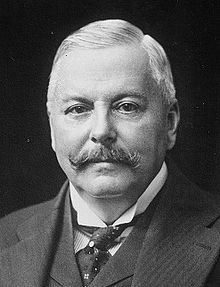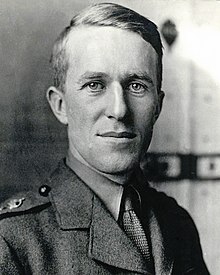胡適1926年8月9日在倫敦見四位名人:Sir Arthur Shipley. Archibald Rose. Colonel Lawrence (T. E. Lawrence 即阿拉伯勞倫斯). Sir Herbert Baker
Arthur Everett Shipley
| |
|---|---|
 | |
| Born | March 10, 1861 |
| Died | September 22, 1927 (aged 66) |
| Education | University College School St Bartholomew's Hospital (withdrew) Christ's College, Cambridge |
Sir Arthur Everett Shipley GBE FRS (10 March 1861 – 22 September 1927) was an English zoologist and Vice-Chancellor of the University of Cambridge.
---
Charles Archibald Walker Rose CIE FRGS (1879–1961), ubiquitously known as Archie Rose, was a British diplomat, explorer and businessman in China during the early twentieth century.[1] Rose's obituary in The Times stated that he was 'a lovable and saint-like man. His dandiacal appearance and his taste for drollery were unsure guides to his true character, in which the dominant strain was a sort of earnest but unobtrusive chivalry'.[1]
Early life[edit]
Archie Rose, the son of Thomas Edward Rose, was born on 14 July 1879.[2] He was educated at Bedford Modern School and King's College, London, before becoming a student interpreter at the British Legation in Peking in 1897.[3]
China[edit]
He was awarded the China War Medal and clasp for his role in the defence of western embassies during the Boxer Rebellion in 1900.[4] and provided a lively eye-witness account of life in the Legations during the sieges, for example from Monday 25 June 1900:
'These people are the most shockingly bad shots fortunately for us. If a quarter of their shots and shells came anywhere near our walls and buildings we should all have been in suitable resting-places long ago. They must be utter rotters. If they had any pluck there are several places where they could get into the compound and smash us easily. Every day we are fortifying, trenching, barricading, doing everything that is possible, whilst they stay at a safe distance and blaze away like fun'.[5]
In 1903 he was appointed British Consul at Chongqing,[6] and subsequently became consul at Chefoo, Ningpo, Hangchow and Tengyue.[7] He also travelled extensively in China, Mongolia and Central Asia and collaborated on an ethnological study of the tribes of the Chinese-Burmese border region.[8]
In 1911 he was appointed CIE and in the same year returned to England to attend an advanced course in Chinese at King's College, Cambridge.[9] Here, he befriended John Maynard Keynes and the two were to maintain a long-running correspondence.[10] He was also elected a Fellow of the Royal Geographical Society for his exploration work.[11][12]
On his return to Asia he served as the Foreign Office representative at the tripartite conference on the subject of the independence of Tibet held at Simla over the winter of 1913-14 and which led to the Simla Accord. In 1915 he was Commercial Attache at Shanghai and from 1917 he held the same position at the Peking embassy.[7] During this period he also developed an enthusiasm for ballroom-dancing to the extent that he was referred to by his friend George Ernest Morrison, The Times China Correspondent, as 'Professor of dancing and deportment in the department of commerce'.[13]
Later life[edit]
Rose retired from the Foreign Office with the rank of First Secretary in 1921, and embarked on a career in business in the Far East; becoming a Director of British American Tobacco and the Chartered Bank of India, Australia and India. He retired to England at Framlingham, Suffolk, and became a JP for the County. He died on the 3rd. March, 1961.[14]
--
|
T. E. Lawrence
| |
|---|---|

Lawrence in 1918
| |
| Birth name | Thomas Edward Lawrence |
| Other name(s) | T. E. Shaw, John Hume Ross |
| Nickname(s) | Lawrence of Arabia |
| Born | 16 August 1888 Tremadog, Carnarvonshire, Wales |
| Died | 19 May 1935 (aged 46) Bovington Camp, Dorset, England |
| Buried |
St Nicholas, Moreton, Dorset
|
| Allegiance | United Kingdom Kingdom of Hejaz |
| Service/ | British Army Royal Air Force |
| Years of service | 1914–1918 1923–1935 |
| Rank | Colonel (British Army) Aircraftman (RAF) |
| Battles/wars | First World War |
| Awards | Companion of the Order of the Bath[1] Distinguished Service Order[2] Knight of the Legion of Honour (France)[3] Croix de guerre (France)[4] |
Thomas Edward Lawrence, CB, DSO (16 August 1888 – 19 May 1935) was a British archaeologist, army officer, military theorist, diplomat, and writer. He was renowned for his liaison role during the Sinai and Palestine Campaign and the Arab Revolt against the Ottoman Empire during the First World War. The breadth and variety of his activities and associations and his ability to describe them vividly in writing, earned him international fame as Lawrence of Arabia, a title used for the 1962 film based on his wartime activities.
He was born out of wedlock in Tremadog, Wales in August 1888 to Sarah Junner, a Scottish governess and Thomas Chapman, an Anglo-Irish nobleman from County Westmeath. Chapman left his wife and family in Ireland to cohabit with Junner; in 1914 he became Sir Thomas Chapman, 7th Baronet. Chapman and Junner called themselves Mr. and Mrs. Lawrence, a name probably adopted from Sarah's likely father; Sarah's mother had been employed as a servant for a Lawrence family when she became pregnant with Sarah.[5] In 1889, the family moved to Kirkcudbright in Scotland where his brother William George was born, before moving to Dinard in France. In 1896, the Lawrences moved to Oxford, where Thomas attended the high school and then studied history at Jesus College from 1907 to 1910. Between 1910 and 1914, he worked as an archaeologist for the British Museum, chiefly at Carchemish in Ottoman Syria.
Soon after the outbreak of war, he volunteered for the British Army and was stationed in Egypt, becoming an officer with the rank of Lieutenant in General Allenby's army. In 1916, he was sent to Arabia on an intelligence mission and quickly became involved with the Arab Revolt as a liaison to the Arab forces, along with other British officers. He worked closely with Emir Faisal, a leader of the revolt, and he participated in and sometimes led military activities against the Ottoman armed forces, culminating in the capture of Damascus in October 1918. Allenby promoted him at first to Major, later to Colonel.
After the war, Lawrence joined the Foreign Office, working with the British government and with Faisal. He was offered both the Victoria Cross and a knighthood but declined both. In 1922, he retreated from public life and spent the years until 1935 serving as an enlisted man, mostly in the Royal Air Force, with a brief stint in the Army. During this time, he published his best-known work Seven Pillars of Wisdom, an autobiographical account of his participation in the Arab Revolt. He also translated books into English and wrote The Mint, which was published posthumously and detailed his time in the Royal Air Force working as an ordinary aircraftman. He corresponded extensively and was friendly with well-known artists, writers, and politicians. For the Royal Air Force, he participated in the development of rescue motorboats.
Lawrence's public image resulted in part from the sensationalised reporting of the Arab revolt by American journalist Lowell Thomas, as well as from Seven Pillars of Wisdom. In 1935, Lawrence was fatally injured in a motorcycle accident in Dorset.
Contents
---
Sir Herbert Baker
| |
|---|---|
 | |
| Born | 9 June 1862
Cobham, Kent, England
|
| Died | 4 February 1946 (aged 83)
Cobham
|
| Occupation | Architect |
| Buildings | India House, London, Glyn, Mills & Co., South Africa House, Monteviot House,[1][2] Union Buildings Pretoria, St John's College, Johannesburg, Wynberg Boys School Emmanuel Centre, Marsham Street, London |
Sir Herbert Baker KCIE FRIBA RA (9 June 1862 – 4 February 1946) was an English architect remembered as the dominant force in South African architecture for two decades, and a major designer of some of New Delhi's most notable government structures. He was born and died at Owletts in Cobham, Kent.
Among the many churches, schools and houses he designed in South Africa are the Union Buildings in Pretoria, St. Andrew's College, Grahamstown, St. John's College, Johannesburg, the Wynberg Boys' High School, Groote Schuur in Cape Town, and the Champagne Homestead and Rhodes Cottage on Boschendal, between Franschhoek and Stellenbosch.[3] With Sir Edwin Lutyens he was instrumental in designing, among other buildings, Viceroy's House, Parliament House, and the North and South Blocks of the Secretariat, all in New Delhi, which in 1931 became the capital of the British Raj, as well as its successor states the Dominion of India and the Republic of India. He also designed the administration building at the then Prince of Wales School in Nairobi, Kenya, now known as Nairobi School. His tomb is in Westminster Abbey.
沒有留言:
張貼留言